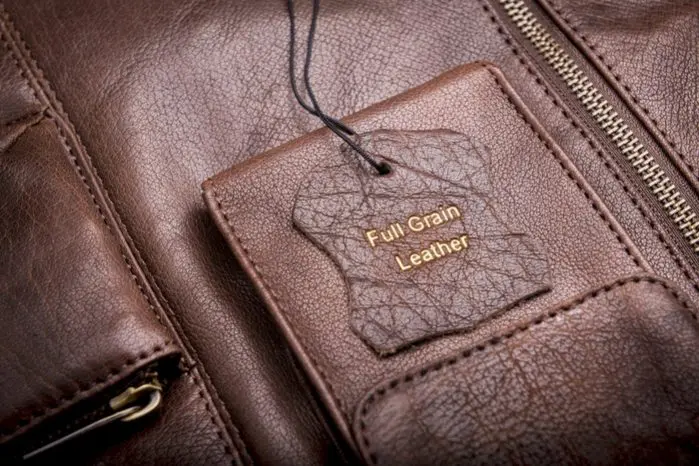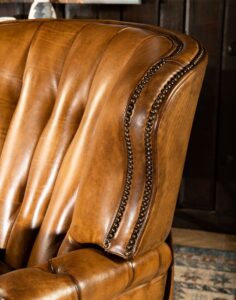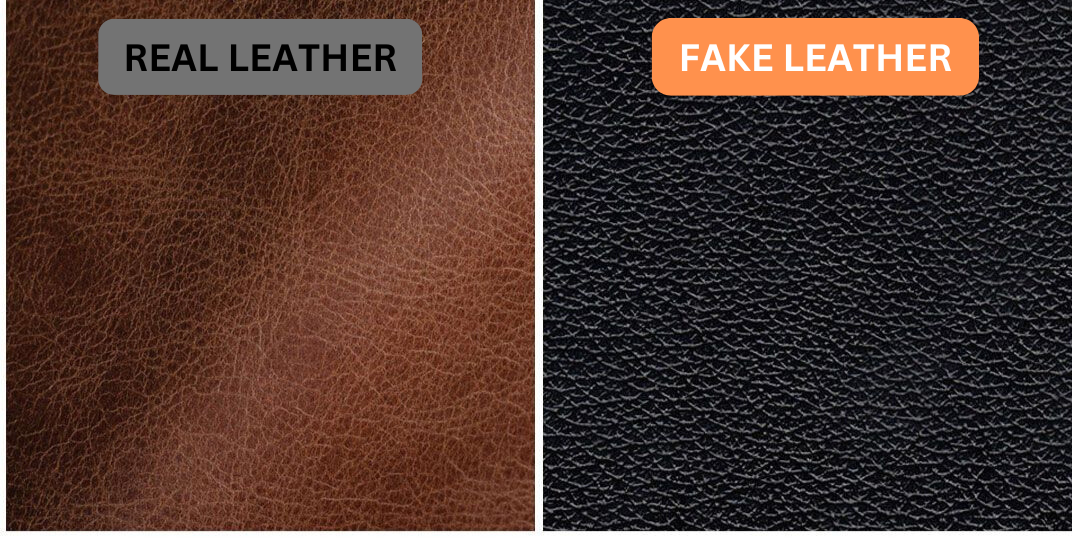What is Real Leather?
Before we dive into “how to tell if leather is real?”, let’s first understand what real leather is? Real leather is a natural material made from the hide of animals. It’s prized for its toughness, versatility, and enduring style. To obtain leather, animal hides go through tanning process. This process preserves the hide and turns it into the versatile material we know as leather.
The most common animal hides used for leather are cows, goats, sheep, and buffalo. Exotic leathers, such as crocodile or snake, are also available but far less common.
Misleading Terms in the Market
In today’s market, it’s easy to get confused by the many terms that sound like they’re describing real leather but are actually synthetic or man-made materials. Terms like genuine leather, bonded leather, vegan leather, PU leather, leatherette, pleather, faux leather, and others are often used to mislead buyers. While these materials are designed to mimic the look of leather, they can’t truly replicate the qualities we love about real leather, like its natural texture, durability, and ability to age beautifully.
Let me be clear: genuine leather is one of the most misleading terms. It’s often used as a marketing gimmick to sell scrap or low-quality leather. So, while it technically is leather, it doesn’t meet the standards of what I’d call real leather.
When looking for real leather, focus on premium types such as:
- Full-grain leather
- Top-grain leather
- Suede
- Nubuck
- Nappa leather
These materials offer the durability, natural texture, and quality that real leather enthusiasts value.
For a deeper dive into the world of high-quality leathers, check out our article on Genuine vs Full Grain Leather to learn more about the differences and benefits of each.
The Problem with Synthetic Leather
Most fake leathers, like PU leather or leatherette, are made from plastic. While they might look convincing, they lack the qualities that make real leather unique. They don’t age the same way, they’re less durable, and they can’t replicate the natural feel and smell of authentic leather.
In this article, I’ll guide you through how to tell if leather is real, how can you tell fake leather from real leather, and tips for spotting real leather in items like jackets and bags. Let’s dive in and make sure you get the real thing!
How to Tell if Leather is Real: Key Characteristics
When it comes to identifying real leather, I always say that the feel is the most important giveaway. The moment you touch a leather product, you know whether it’s the real deal or not. Fake leather just can’t replicate the organic, supple feel of real leather.
A real leather product has a unique, organic texture that’s hard to mimic. You’ll notice the natural grain pattern, stretch marks, bug bites, and imperfections that make each piece truly one-of-a-kind. It’s a luxurious feel that’s impossible to fake.
Now, I know what you’re thinking – what if I’m not sure? What if I’ve never felt real leather before? Don’t worry, there are plenty of other ways to spot a fake.
Don’t Fall for the Fake: Read the Label Carefully
When shopping for leather goods, the product label is your best friend. A genuine brand or retailer will proudly display the type of leather used, whether it’s full-grain, top-grain, or another type. If you see these details, it’s a good sign that you’re dealing with real leather.
However, not all labels are created equal. Some fake leather products will try to hide behind marketing gimmicks like “genuine leather,” “pure leather,” or “original leather.” These terms sound impressive, but they don’t give you any real information about the leather.
On the other hand, if a label says “PU leather,” “Faux leather,” or “bonded leather,” at least you know what you’re getting. It’s up to you to decide whether you want to opt for synthetic leather or the real deal.
Here’s a pro tip: if a label seems vague or tries to make the leather sound more luxurious than it is, it’s likely a red flag. Always prioritize transparency and clarity when shopping for leather goods.
Get Hands-On: The Feel Test for Real Leather
We’ve already established that the feel of leather is a dead giveaway when it comes to authenticity. But let’s dive deeper. When you touch real leather, it feels warm and inviting. Fake leather, on the other hand, can feel cold, dead, or synthetic.
Now, pay attention to the texture. Is it foamy or dense? A more foamy leather is often a sign of cheap or fake leather. This is because fake leathers are manufactured using a rapid chemical process that breaks down the fiber structure, creating a separated, foamy feel.
Real leather, on the other hand, is tanned slowly using natural fats, oils, and approved chemicals. This process creates a densely packed fiber structure that feels solid and luxurious to the touch.
Here’s a simple trick: Gently press your fingers into the leather. If it feels spongy or springy, it might be fake. Real leather will have some give, but it should feel firm and supple.
The Grain Game: A Dead Giveaway for Fake Leather
When it comes to identifying real leather, the grain pattern is a crucial factor. Take a closer look at the leather and try to spot the grain. Real leather will have visible, inconsistent grain patterns with unique imperfections like bite marks, cracks, and fades. It’s like a fingerprint – no two pieces of real leather are alike.
On the other hand, fake leather often lacks grain patterns altogether, or features replicated designs with perfect structures and no fades or inconsistencies. It’s just too perfect!
Here’s a simple trick: pinch the leather gently. Real leather will change texture and show fading near the point of contact. Fake leather won’t exhibit this characteristic.
As an leather enthusiast, I can tell you that the grain patterns and their inconsistencies are a major part of the appeal. Whether it’s a leather bag, jacket, or boots, the unique grain pattern is what makes it special.
“Step up your shoe game with our comprehensive Leather Shoe Guide, featuring the latest styles, trends, and expert care tips to keep your leather shoes looking their best.”
One more thing to check for: visible hair follicles and veins. Since real leather is made from animal hides, it will often feature visible hair follicles and scratch marks. Fake leather, on the other hand, will be smooth and uniform.
So, the next time you’re shopping for leather goods, remember: How to tell if leather is real starts with checking the grain. And if you’re still unsure, just pinch it!
Stay on top of the latest fashion trends with our article on Leather Jacket Trends for 2025, your ultimate guide to stylish and timeless leather jackets.
Follow Your Nose: The Smell Test for Real Leather
When it comes to identifying real leather, your sense of smell can be a powerful tool. High-quality leather, regardless of whether it’s chrome-tanned or vegetable-tanned, has a distinct scent that comes from the tanning process.
Real leather is tanned using natural oils, fats, and waxes, which gives it a rich, earthy aroma. Whether it’s the sweet smell of vegetable-tanned leather or the slightly tangy scent of chrome-tanned leather, the smell of real leather is unmistakable.
On the other hand, fake or cheap leather often has a harsh, unpleasant smell that’s reminiscent of plastic. This is because cheap leather is often made using low-quality chemicals that give off a strong, acrid scent. Remember, how to tell if leather is real is all about paying attention to the details. And when it comes to smell, real leather is unmistakable.
However, be cautious: some manufacturers are now using advanced methods to replicate the smell of real leather in fake leather products. So, while the smell test can be helpful, it shouldn’t be your only parameter for judging a leather’s authenticity.
Look Beyond the Surface: Checking the Edge of Leather
When it comes to identifying real leather, it’s easy to get fooled by the surface appearance. But one way to reveal the truth is to take a closer look at the edge of the leather.
Fake leather will often have multiple layers stuck together, creating a thick, uneven appearance. This is because cheap, mass-produced leathers are made by layering low-quality split leathers or vinyl layers on top of each other.
Real leather, on the other hand, has a uniform, dense structure. If you examine the cross-section of real leather, you’ll see the grain patterns visible on the top portion.
Here’s a simple trick: gently peel back the edge of the leather to reveal the layers beneath. If you see multiple layers or a messy, uneven structure, it’s likely fake leather.
The Patina Test: How Your Leather Ages Reveals Its Secrets

If you already own a leather product and are curious about its authenticity, there’s a simple way to find out. Just take a closer look at the condition of the leather.
Real leather has a unique ability to develop a rich patina over time. This means that it will gradually darken, soften, and develop a beautiful, luxurious sheen. It’s like a fine wine – it only gets better with age!
On the other hand, fake or cheap leather will not develop any character or patina. Instead, it will lose its luster and shape over time, often becoming dull, stiff, and cracked.
Here’s a simple rule of thumb: if your leather product looks great when you first buy it but quickly deteriorates, it’s probably fake leather. Real leather, on the other hand, will only get more beautiful with time.
So, if you’re wondering how to tell if leather is real, just take a closer look at how it’s aged.
“Want to learn how your leather goods can develop a beautiful, worn-in look? Check out A Guide to Leather Patina for insider tips on how leather ages and develops its unique character.”
The Water Test: A Simple Trick to Reveal Fake Leather
Are you ready for a simple yet effective test to check if your leather is real? Look no further than the water test!
Here’s how it works: just drop a few drops of water onto the leather. If the water is absorbed into the leather, it’s likely to be real. On the other hand, if the water beads up and rolls off, it’s probably fake or PU leather.
But here’s the thing: some leather products are treated with waxes or oils that can affect the water test. In these cases, the water might be absorbed slowly or even bead up like on fake leather. So, while the water test is a great indicator, it’s not foolproof.
That’s why it’s essential to combine the water test with other methods, like checking the grain, feeling the texture, and examining the edge. By using a combination of these tests, you’ll be able to tell if your leather is real or fake.
So, the next time you’re wondering how to tell if leather is real, remember the water test.
The Flame Test: Not Exactly a Retail-Friendly Option!
Let’s talk about the flame test – a surefire way to check if your leather is real or fake. Here’s how it works: expose the leather to a flame, and if it’s real, it will char and smell like burnt hair. If it’s fake, it will melt and smell like burning plastic.
But, let’s get real – this test is not exactly feasible (or safe!) for everyday use. I mean, can you imagine walking into a store and asking the shopkeeper if you can set their leather handbags on fire? Yeah, that’s not going to fly!
So, while the flame test might be a fun party trick, it’s not exactly a practical or recommended method for checking leather authenticity. Instead, stick with the other tests we’ve discussed, like checking the grain, feeling the texture, and examining the edge.
By using these tests, you’ll be able to tell if your leather is real or fake without getting kicked out of the mall!
Beyond the Basics: Advanced Authentication Methods to Verify Leather Authenticity
Now that we’ve covered the basics, let’s dive into some advanced methods for verifying leather authenticity. These techniques can provide an added layer of assurance for those seeking high-quality, real leather products.
Labeling and Certification: The Seal of Approval
When shopping for leather products, keep an eye out for labels and certifications from reputable organizations, such as the Leather Working Group (LWG) or the International Council of Tanners (ICT). These certifications ensure that the leather meets certain standards for quality, sustainability, and authenticity.
DNA Testing and Spectroscopy: The Science of Leather Authentication
In recent years, advanced technologies like DNA testing and spectroscopy have emerged as powerful tools for leather authentication. These methods can detect the presence of specific proteins, fibers, or chemicals that are unique to real leather.
Expert Opinion: The Human Touch
By combining these advanced methods with the basic tests we discussed earlier, you’ll be well-equipped to verify the authenticity of leather products and make informed purchasing decisions.
The Dark Side of Fake Leather: Uncovering the Consequences
Now that we’ve explored the ways to spot fake leather, let’s take a closer look at the consequences of this growing problem. From environmental damage to economic disruption, the impact of fake leather is far-reaching and alarming.
The Environmental Impact: A Toxic Legacy
The production of fake leather involves the use of synthetic materials, chemicals, and plastics, which can harm the environment in several ways. The manufacturing process releases toxic chemicals into the air and water, contributing to pollution and climate change. Moreover, fake leather is often made from non-biodegradable materials, which can take hundreds of years to decompose.
Curious about the eco-friendly credentials of vegan leather? Dive into this in-depth article on the “Is Vegan Leather Sustainable? The Answer Is Complicated”
The Economic Impact: A Blow to the Fashion and Leather Industries
The rise of fake leather has significant economic implications for the fashion and leather industries. Counterfeit leather products can undermine the reputation of legitimate brands, leading to financial losses and damage to their reputation. Furthermore, the influx of cheap, fake leather products can disrupt the market, making it challenging for real leather producers to compete.
The Social Impact: A Hidden Cost
The social consequences of fake leather are often overlooked but are nonetheless significant. Consumers who unknowingly purchase fake leather products may be exposed to toxic chemicals and allergens, which can cause health problems. By understanding the consequences of fake leather, we can appreciate the importance of verifying the authenticity of leather products. How to tell if leather is real is not just about saving money or avoiding scams – it’s also about protecting the environment, supporting legitimate industries, and promoting fair labor practices.

